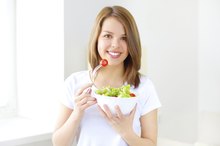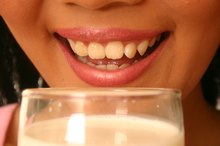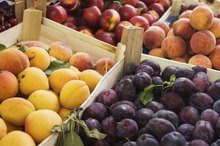The Best Supplements for Teenage Girls
Your daughter should get the nutrients she needs through her diet, but in some cases your teenager might not get all of the nutrients that her growing body needs. She may be a picky eater or follow a vegetarian diet, which may not include all necessary nutrients. You may need to add supplements to her diet for her body to be healthy. However, check with your daughter's physician before adding any supplements to her diet.
Iron
Teenage girls are 10 times as likely as boys to develop anemia. The National Anemia Action Council attributes this risk to rapid growth and menstruation. Anemia occurs when iron is deficient in your body. Low iron levels can make you feel tired, weak, cause your skin to be pale and decrease your appetite. Risk factors include poor performance in school, decreased verbal learning and diminished memory.
Your teenage daughter needs to consume 15mg of iron each day. Serve her foods high in iron such as green, leafy vegetables and dried beans. You can also serve her breakfast cereals that are fortified with iron to increase her intake. You may need to supplement her diet if she is not consuming enough iron through her food. Give her a multivitamin that includes iron or give her a separate iron supplement.
- Teenage girls are 10 times as likely as boys to develop anemia.
- You may need to supplement her diet if she is not consuming enough iron through her food.
Calcium and Vitamin D
How Much Protein Per Day for a Teenage Girl?
Learn More
Your teenage daughter needs to consume 1,300mg of calcium each day according to GirlsHealth.gov. She needs 30 percent more calcium than adults. Calcium is important for strong bones, which grow rapidly during her teen years. Serve her low-fat milk, cheese, yogurt and cottage cheese to help her get the calcium she needs. Vitamin D works side-by-side with calcium and aids absorption. Not only does she need to consume vitamin D through her diet, she needs to spend time outside in the sun also. Give your daughter milk fortified with vitamin D to ensure she gets what she needs. In some cases, your teenager may not consume enough calcium or vitamin D. You may need to give her calcium and vitamin D supplements to support her growth spurt.
- Your teenage daughter needs to consume 1,300mg of calcium each day according to GirlsHealth.gov.
- In some cases, your teenager may not consume enough calcium or vitamin D. You may need to give her calcium and vitamin D supplements to support her growth spurt.
Folate
Women of childbearing age need to consume folate to avoid neural tube defects in a growing fetus. Folate is also important for your body to make red blood cells. Teenage girls need to consume 400mcg of folate each day, according to website TeensHealth 1. Ensure that she is consuming folate-rich foods such as green, leafy vegetables, legumes and cereals fortified with folate. In addition to this, give her a multivitamin that has folate. Nutrition labels may also list folate as vitamin B9 or folic acid.
- Women of childbearing age need to consume folate to avoid neural tube defects in a growing fetus.
- In addition to this, give her a multivitamin that has folate.
Related Articles
References
- TeensHealth: Vitamins
- U.S. Department of Health and Human Services. National Institutes of Health. Iron Fact Sheet for Health Professionals. Office of Dietary Supplements. Published 2019.
- Sun J, Zhang L, Cui J et al. Effect of dietary intervention treatment on children with iron deficiency anemia in China: a meta-analysis. Lipids Health Dis. 2018;17(1). doi:10.1186/s12944-018-0749-x
- Beck KL, Conlon CA, Kruger R, Coad J. Dietary determinants of and possible solutions to iron deficiency for young women living in industrialized countries: a review. Nutrients. 2014;6(9):3747-76. doi:10.3390/nu6093747
- Hurrell R, Egli I. Iron bioavailability and dietary reference values. Am J Clin Nutr. 2010;91(5):1461S-1467S. doi:10.3945/ajcn.2010.28674F
- Institute of Medicine. 2001. Dietary Reference Intakes for Vitamin A, Vitamin K, Arsenic, Boron, Chromium, Copper, Iodine, Iron, Manganese, Molybdenum, Nickel, Silicon, Vanadium, and Zinc. Washington, DC: The National Academies Press. doi:10.17226/10026
- Zijp IM, Korver O, Tijburg LB. Effect of tea and other dietary factors on iron absorption. Crit Rev Food Sci Nutr. 2000;40(5):371-98. doi:10.1080/10408690091189194
- Centers for Disease Control and Prevention. Iron.
- Makrides, M., Hawkes, J. S., Neumann, M. A., & Gibson, R. A. (2002). Nutritional effect of including egg yolk in the weaning diet of breast-fed and formula-fed infants: a randomized controlled trial. The American Journal of Clinical Nutrition, 75(6), 1084–1092. doi:10.1093/ajcn/75.6.1084
- Itske M. Zijp, Onno Korver & Lilian B. M. Tijburg (2000) Effect of Tea and Other Dietary Factors on Iron Absorption, Critical Reviews in Food Science and Nutrition,40:5, 371-398, doi:10.1080/10408690091189194
- Lönnerdal, B. (2010). Calcium and Iron Absorption - Mechanisms and Public Health Relevance. International Journal for Vitamin and Nutrition Research, 80(45), 293–299. doi:10.1024/0300-9831/a000036
- Geerligs PD, Brabin BJ, Omari AA. Food prepared in iron cooking pots as an intervention for reducing iron deficiency anaemia in developing countries: a systematic review. J Hum Nutr Diet. 2003;16(4):275-81. doi:10.1046/j.1365-277X.2003.00447.x
- Abhilash KP, Arul JJ, Bala D. Fatal overdose of iron tablets in adults. Indian J Crit Care Med. 2013;17(5):311-3. doi:10.4103/0972-5229.120326
- Hamilton JPA, By, Hamilton JPA. Secondary Iron Overload - Blood Disorders. Merck Manuals Consumer Version.
- Iron - Infant and Toddler Nutrition. Centers for Disease Control and Prevention. Published 2018.
- Milk Free Diet For Iron Deficiency Anemia. Children's Hospitals and Clinics of Minnesota.
- Abhilash KP, Arul JJ, Bala D. Fatal overdose of iron tablets in adults. Indian J Crit Care Med. 2013;17(5):311–313. doi:10.4103/0972-5229.120326
- Beck KL, Conlon CA, Kruger R, Coad J. Dietary determinants of and possible solutions to iron deficiency for young women living in industrialized countries: a review. Nutrients. 2014;6(9):3747–3776. Published 2014 Sep 19. doi:10.3390/nu6093747
- de Benoist B, McLean E, Egil I, Cogswell M, eds. Worldwide Prevalence of Anaemia 1993-2005. World Health Organization, Centers for Disease Control and Prevention.
- Geerligs P, Brabin B, Omari A. Food prepared in iron cooking pots as an intervention for reducing iron deficiency anaemia in developing countries: a systematic review. Journal of Human Nutrition and Dietetics. 2003;16(4):275-281. doi:10.1046/j.1365-277x.2003.00447.x
- Hamilton, JPA. Secondary Iron Overload - Blood Disorders. Merck Manuals Consumer Version. February 2019.
- Hurrell R, Egli I. Iron bioavailability and dietary reference values. The American Journal of Clinical Nutrition. 2010;91(5). doi:10.3945/ajcn.2010.28674F
- Johnson-Wimbley T, Graham D. Diagnosis and management of iron deficiency anemia in the 21st century. Therap Adv Gastroenterol. 2011;4(3):177-184. doi:10.1177/1756283x11398736
- Verster A. Food fortification: good to have or need to have? Eastern Mediterranean Health Journal. 2004;10(6).
Writer Bio
Melodie Anne Coffman specializes in overall wellness, with particular interests in women's health and personal defense. She holds a master's degree in food science and human nutrition and is a certified instructor through the NRA. Coffman is pursuing her personal trainer certification in 2015.









